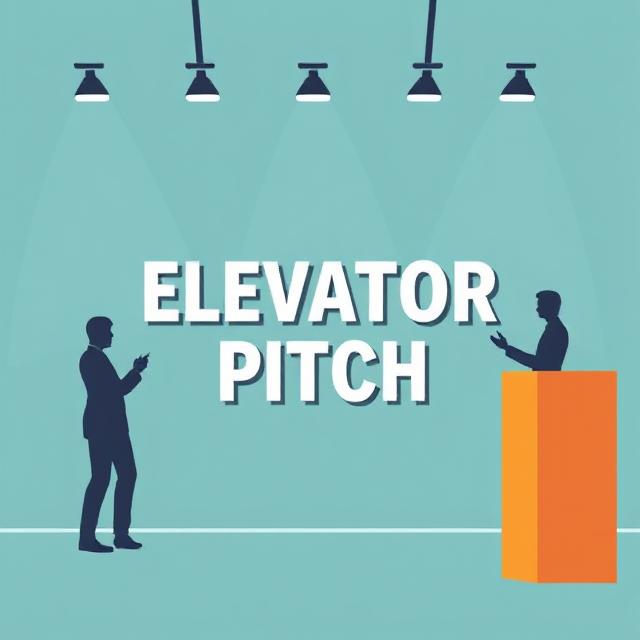table of contents
Ever struggled to explain what you do in a way that actually grabs attention? That is where an elevator pitch saves the day.
So, what is an elevator pitch? It is your chance to introduce yourself, your business, or your idea in a way that is quick, clear, and memorable—perfect for networking, investor meetings, or even casual chats.
Need a little inspiration? Check out some elevator pitch examples to see what works. And if writing one feels like a chore, Draaft makes it effortless! It is an all-in-one platform that helps you create all polished, professional documents—including elevator pitches—in minutes. Just pick a ready-made template, customize it, and you are good to go.
Let’s make sure your next pitch leaves a lasting impression!
What Is an Elevator Pitch?
This is a short, compelling summary that explains who you are, what you do, and why it matters all within 30 to 60 seconds. The name comes from the idea that you should be able to deliver it in the time it takes for an elevator ride.
What Makes an Elevator Pitch Effective?
A powerful pitch is:
✅ Concise – 75 words or less.
✅ Engaging – It starts with a hook that sparks curiosity.
✅ Value-driven – It quickly answers “What’s in it for them?”
Want to craft a killer pitch without the struggle? Draaft has ready-to-use templates that make the process effortless. Just pick one, tweak it to fit your style, and deliver your pitch with confidence!
When Can You Use an Elevator Pitch?
It’s a powerful communication tool used in various real-world situations. If delivered right, it can increase your chances of making an impact by 50%. Let’s check when and why you need one.
1️⃣ Networking Events & Conferences
💡 Fact: 80% of professionals say that effective networking has been crucial to their career success.
📌 Why Use a Pitch Here? In a crowded room, you often have just 30 seconds to introduce yourself before the conversation moves on. A concise pitch ensures you’re remembered.
2️⃣ Job Interviews & Career Fairs
💡 Fact: Recruiters spend an average of 6–8 seconds scanning a resume before deciding whether to proceed.
📌 Why Use a Pitch Here? A well-structured elevator pitch helps you make an immediate, strong impression, summarizing your value before diving into details.
3️⃣ Sales & Business Pitches
💡 Fact: 74% of buyers say they’ll do business with a company if their representative can clearly articulate value in under a minute.
📌 Why Use a Pitch Here? Whether you’re pitching to investors, selling a service, or introducing a product, a sharp, engaging message helps you win attention and close deals.
4️⃣ Cold Emails & Social Media Introductions
💡 Fact: The average open rate for cold emails is 21.33%, but well-crafted, personalized pitches increase response rates by 50%.
📌 Why Use a Pitch Here? A compelling introduction in an email or LinkedIn message can turn a cold connection into a warm lead.
5️⃣ Internal Meetings & Promotions
💡 Fact: 85% of promotions go to employees who can effectively communicate their contributions.
📌 Why Use a Pitch Here? Whether you’re proposing a new idea, requesting a raise, or positioning yourself for a leadership role, a structured self-presentation can set you apart.
So, this is a golden ticket to grabbing attention in high-stakes moments. Want to craft one effortlessly?
What are the Different Types of Elevator Pitches?
This is not one-size-fits-all. Depending on your audience, purpose, and industry, your approach should change. Let’s check the most effective types of elevator pitches, backed by insights and real-world applications.
1. The Classic 30-Second Pitch (The Power Puncher)
🔹 Best for: Networking events, interviews, career fairs
🔹 Why it works: People remember only 10% of what they hear in conversations (Forbes, 2023). A short, structured message sticks.
🔹 Example:
“I’m Alex, a UX designer with 5+ years of experience crafting intuitive digital experiences. My recent project boosted user engagement by 40%. I specialize in turning complex ideas into seamless interfaces. Let’s talk about how I can bring that impact to your team!”
- The Problem-Solution Pitch (The Attention Grabber)
🔹 Best for: Investors, potential clients, sales pitches
🔹 Why it works: People buy solutions, not products. If you address pain points immediately, you win their attention.
🔹 Example:
“70% of small businesses struggle with lead conversion. Our AI-driven CRM automates follow-ups, increasing conversions by 45%. I’d love to show you how it works.”
3. The Story-Driven Pitch (The Emotional Hook)
🔹 Best for: TED-style talks, brand storytelling, leadership pitches
🔹 Why it works: Narratives boost retention by 22X (Stanford, 2023). People connect with stories, not bullet points.
🔹 Example:
“Five years ago, I was drowning in debt from failed e-commerce ventures. Then, I built a Shopify automation tool—now helping 5,000+ sellers triple their revenue. If you’ve faced similar struggles, let’s talk.”
4. The “What-If” Pitch (The Curiosity Sparkler)
🔹 Best for: Innovative startups, product launches, disruptive ideas
🔹 Why it works: Posing a question engages the brain instantly (Harvard Business Review, 2023). It forces the listener to think and respond.
🔹 Example:
“What if you could cut your marketing budget in half but double conversions? That’s exactly what our AI-powered tool does.”
5. The Tweet Pitch (The Digital Age Hook)
🔹 Best for: Social media, cold outreach, email intros
🔹 Why it works: People scroll past 95% of content in under 3 seconds (Meta, 2023). Brevity = impact.
🔹 Example:
“Helping startups get their first 1,000 users—without ads. Let’s chat!”
6. The Reverse Pitch (The Role Reversal Strategy)
🔹 Best for: High-stakes meetings, negotiation scenarios
🔹 Why it works: Instead of telling them why they need you, you make them sell themselves to you.
🔹 Example:
“Many companies struggle with remote team productivity. What’s been your biggest challenge so far?”
So, choose the right type based on your goal and audience. Want a flawless, ready-to-use pitch in minutes? Draaft has got you covered with customizable, high-impact templates. Try it today!
How to Write an Elevator Pitch That Actually Works?
Most people butcher their elevator pitch. They ramble. They sound robotic. Or worse—they’re instantly forgettable. But you? You’re about to craft one that hooks attention in seconds.
Let’s break this down like a real conversation, not another boring formula.
Step 1: Forget Everything You’ve Heard About Elevator Pitches
You don’t need a script. You don’t need to impress everyone. And you definitely don’t need to cram your entire career into 30 seconds.
💡 What you actually need?
A way to make people care enough to want more.
Step 2: Start With a “Hook” That Snaps Attention
If you start with:
❌ “Hi, I’m Sarah, a marketing specialist with 10 years of experience…” 😴
Most people mentally check out.
Instead, grab their attention with a punchy opening:
✅ A shocking stat: “Did you know 90% of startups fail because they market to the wrong audience?”
✅ A bold question: “Ever wonder why some brands explode overnight while others flop?”
✅ A problem they relate to: “Most small businesses waste 50% of their ad budget without realizing it.”
👀 Why does this work?
It instantly makes the listener curious. And curiosity = attention.
Step 3: Say What You Do, But Make It Matter
Nobody cares about your job title—they care about what you can do for them.
❌ Weak: “I’m a software developer at XYZ Tech.”
✅ Strong: “I help businesses automate workflows so they save 20+ hours a week.”
👉 Formula: “I help [WHO] achieve [WHAT] by [HOW].”
🔥 Example: “I help startups grow their email lists 5X faster—without running a single paid ad.”
Step 4: Add a Mini “Wow Factor”
This is your proof. Give a quick result, social proof, or unique value.
🚀 Example:
“I scaled a startup’s revenue from $10K to $500K in 6 months using a no-ads growth strategy.”
👑 Why this works?
People trust real impact, not empty claims.
Step 5: End With an Invitation, Not a Dead End
Most pitches awkwardly stop, leaving the other person unsure what to do next. Instead, guide the conversation forward.
🎯 Examples:
✅ “Would love to hear how you approach this in your industry.”
✅ “If that sounds interesting, let’s grab a quick call.”
✅ “I’d be happy to share some quick wins you can apply right away.”
This makes it a conversation, not a monologue.
BONUS: Make It So Simple a 10-Year-Old Understands It
If you can’t explain what you do in plain English, you’re doing it wrong.
❌ Complicated: “I implement AI-driven B2B lead generation strategies for scalable growth.”
✅ Clear & Simple: “I help businesses get more customers without wasting money on ads.”
TL;DR – The 5-Step Elevator Pitch Formula That Works Every Time
1️⃣ Start with a hook (stat, question, or problem).
2️⃣ Explain what you do in one sentence (Who + What + How).
3️⃣ Add a mini “wow factor” (result, proof, or unique edge).
4️⃣ Guide the conversation forward (ask, invite, or suggest).
5️⃣ Keep it insanely simple.
Now, go test this. Watch how people actually lean in when you talk.
Elevator Pitch FAQs
1. What is an elevator pitch?
- A short, impactful introduction about yourself or your idea.
- Typically 30–60 seconds long to grab attention quickly.
- Designed to spark interest and start a conversation.
2. What is the elevator pitch meaning?
- A concise and persuasive speech about a person, business, or idea.
- A way to communicate your value effectively in a short time.
- A technique used in networking, sales, and interviews.
3. Can you share some elevator pitch examples?
- For a marketer: “I help brands 5X their social media engagement without paid ads.”
- For a startup founder: “Our app reduces food waste by connecting restaurants with local food banks.”
- For an engineer: “I design AI tools that help businesses automate repetitive tasks and save 20+ hours weekly.”
4. What are some elevator pitch examples for students?
- For a job interview: “I’m a marketing student passionate about social media trends and data-driven campaigns.”
- For networking: “I’m an engineering student specializing in sustainable tech solutions for the future.”
- For internships: “I love coding and have built three apps that help students manage their schedules.”
5. What is elevator pitch MTV?
- A reality TV show where entrepreneurs pitch their startups in an elevator setting.
- Contestants get 60 seconds to convince investors before doors open.
- A high-stakes pitch scenario that tests clarity, confidence, and persuasiveness.
6. How to craft an elevator pitch for an interview?
- Start with your name and background in one sentence.
- Highlight your key skills and achievements in a compelling way.
- End with why you’re a great fit for the role and show enthusiasm.
Example: “I’m Alex, a data analyst with experience in predictive modeling. I recently optimized a company’s sales forecasting, improving accuracy by 30%. I’m excited about using data to drive smarter business decisions.”
7. How to use an elevator pitch template effectively?
- Start with a strong hook (a question, stat, or problem statement).
- Explain what you do in simple words.
- Showcase your unique value with proof or results.
- End with a clear next step or invitation.
Meet Draaft: Your All-in-One Document Creation Platform
Crafting compelling introductions for yourself, your business, or your idea shouldn’t feel like rocket science. That is why Draaft is here. This is not yet another tool; it is a well-trusted, high-grade, and truly reliable platform that allows you to create professional documents without any hassle. From a powerful elevator pitch to a successful business proposal and everything in between, Draaft makes document creation a breeze in just a matter of minutes.
Stop struggling with formatting and structuring—let Draaft handle the heavy lifting while you focus on making a lasting impression. Ready to craft the perfect pitch? Try Draaft today!



